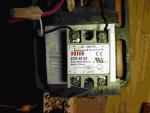Greetings all, I am getting some strange readings off a solid state relay;
I recently replaced a small 8A relay that controls a restive heating element and am getting about 20 volts drop across the relay with my meter, 118V to 98V.
I get the same amp reading on both sides of the relay 5.5A.
I did not get a chance to go thru and check all the other connections as my first instinct is a bad connection somewhere.
The control wires are 20 VDC.
The solid state relay is rated for 40 amps, the load is 5.5 amp.
Is there something about solid state relays that deforms the waveform/phase and could be fooling my meter?
I recently replaced a small 8A relay that controls a restive heating element and am getting about 20 volts drop across the relay with my meter, 118V to 98V.
I get the same amp reading on both sides of the relay 5.5A.
I did not get a chance to go thru and check all the other connections as my first instinct is a bad connection somewhere.
The control wires are 20 VDC.
The solid state relay is rated for 40 amps, the load is 5.5 amp.
Is there something about solid state relays that deforms the waveform/phase and could be fooling my meter?



